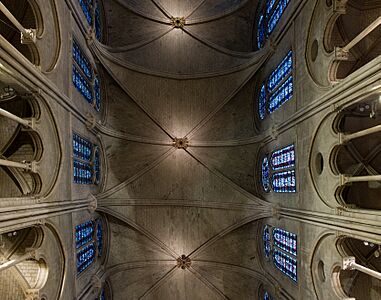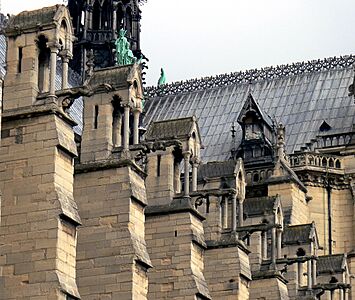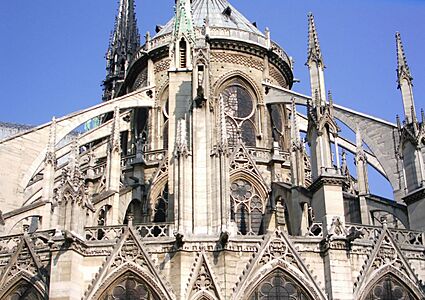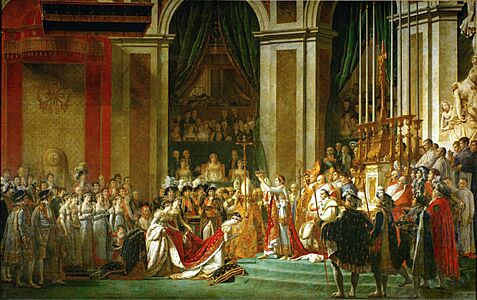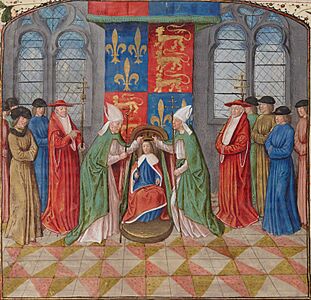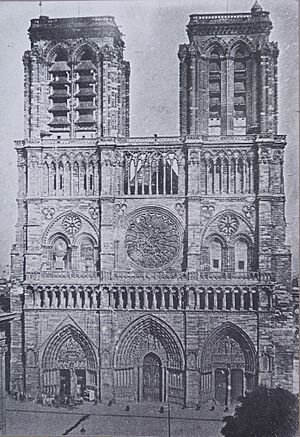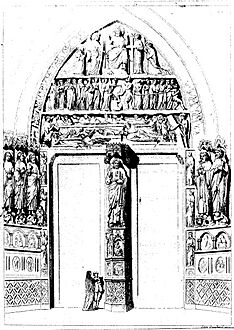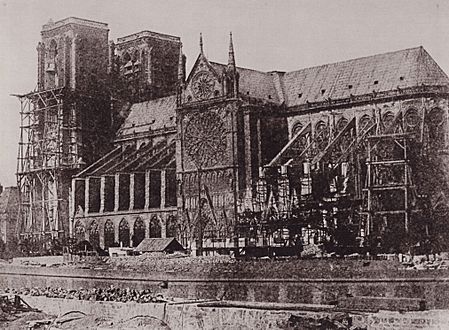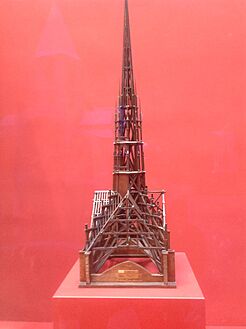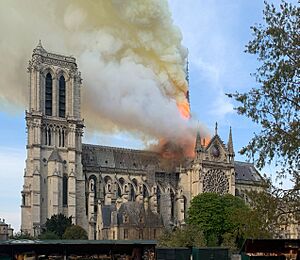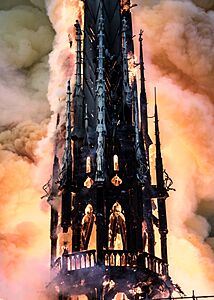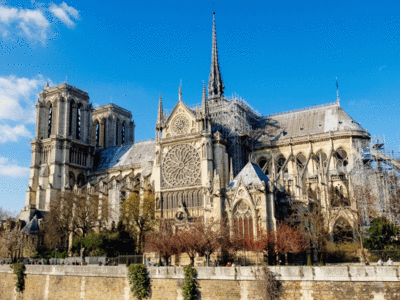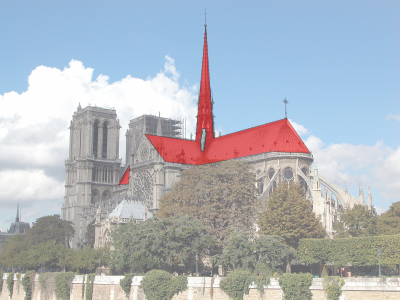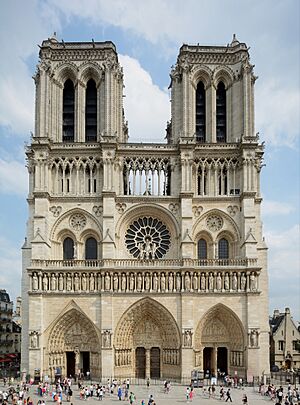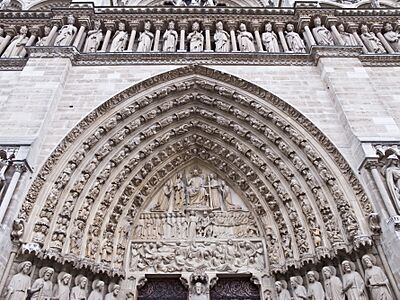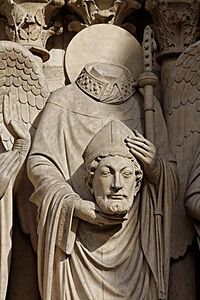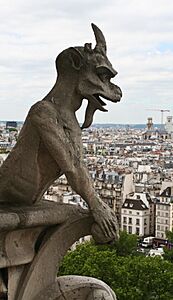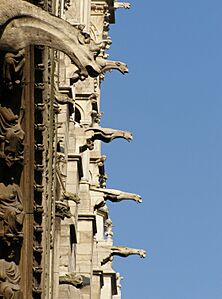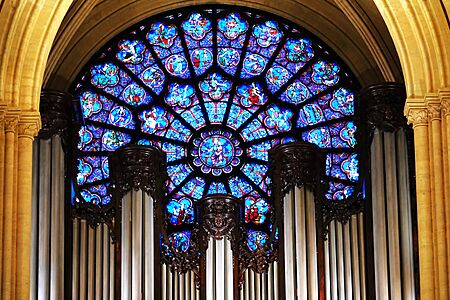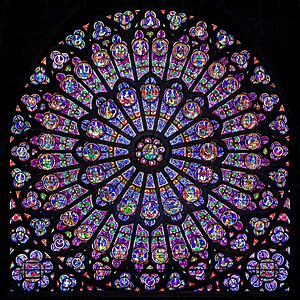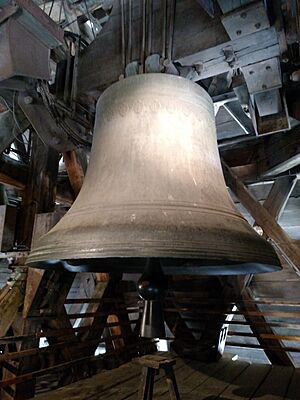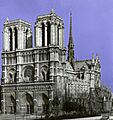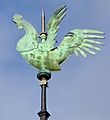Notre-Dame de Paris facts for kids
Quick facts for kids Notre-Dame de Paris |
|
|---|---|
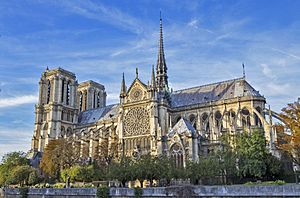
South façade and the nave of Notre-Dame in 2017, two years before the fire
|
|
| 48°51′11″N 2°21′00″E / 48.85306°N 2.35000°E | |
| Location | Parvis Notre-Dame – Place Jean-Paul-II, Paris |
| Country | France |
| Denomination | Catholic Church |
| History | |
| Status | Cathedral, minor basilica |
| Founded | 24 March 1163 to 25 April 1163 (laying of the cornerstone) |
| Founder(s) | Maurice de Sully |
| Consecrated | 19 May 1182 (high altar) |
| Relics held | Crown of thorns, a nail from the True Cross, and a sliver of the True Cross |
| Architecture | |
| Functional status | Reopened 7 December 2024 |
| Architectural type | Gothic |
| Style | French Gothic |
| Years built | 1163–1345 |
| Groundbreaking | 1163 |
| Completed | 1345 |
| Specifications | |
| Length | 128 m (420 ft) |
| Width | 48 m (157 ft) |
| Nave height | 35 metres (115 ft) |
| Number of towers | 2 |
| Tower height | 69 m (226 ft) |
| Number of spires | 1 (the third, completed 16 December 2023) |
| Spire height | 96 m (315 ft) |
| Materials | Limestone and marble |
| Bells | 10 (bronze) |
| Administration | |
| Archdiocese | Paris |
Notre-Dame de Paris, which means "Our Lady of Paris", is a famous medieval Catholic cathedral in Paris, France. It sits on an island in the River Seine called the Île de la Cité. Most people call it simply Notre-Dame. The cathedral is dedicated to the Virgin Mary.
Notre-Dame is one of the best examples of French Gothic architecture. This style was new and exciting when the cathedral was built. It uses special features like ribbed ceilings and flying buttresses, which are stone arches that support the walls from the outside. These features allowed builders to make the walls taller and thinner, with huge, colorful rose windows. The cathedral is also known for its lifelike sculptures, three large pipe organs, and massive church bells.
Building started in 1163 and mostly finished by 1260. Over the centuries, it has been part of many important events. During the French Revolution in the 1790s, many of its religious statues were damaged. In the 1800s, Napoleon was crowned emperor there. The famous book The Hunchback of Notre-Dame by Victor Hugo made people realize the cathedral needed repairs, which led to a big restoration.
In April 2019, a terrible fire destroyed the roof and the tall spire. The cathedral was closed for a massive repair project. It finally reopened to the public in December 2024. Today, Notre-Dame is a powerful symbol of Paris and the entire French nation. Millions of people visit it each year, making it one of the most popular landmarks in Paris.
Contents
History of the Cathedral
Long before Notre-Dame, the site may have held a Roman temple for the god Jupiter. Later, in the 4th or 5th century, an early Christian church called the Cathedral of Saint Étienne was built there. It was about half the size of Notre-Dame.
By 1160, the bishop of Paris, Maurice de Sully, decided the old church was too small for the city's growing population. He wanted to build a much larger and more beautiful cathedral in the new Gothic style. He had the old cathedral torn down and used its materials for the new one.
How Notre-Dame Was Built
The first stone of Notre-Dame was laid in 1163. King Louis VII and Pope Alexander III were there for the ceremony. The building process happened in several stages.
First, workers built the choir, which is the area around the main altar. This was finished around 1177. Next, they built the main body of the church, called the nave. To support the tall walls and roof, they used an important new invention: the flying buttress. These stone arches on the outside of the building carry the weight of the roof, allowing the walls to be thinner and have huge windows.
The famous twin towers on the west front were built between 1220 and 1250. Around the same time, builders added large chapels and beautiful rose windows to the north and south sides of the cathedral. These changes, done in the Rayonnant style, brought even more light inside.
The French Revolution and Napoleon
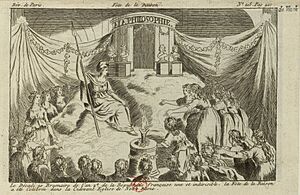
The French Revolution in 1789 was a difficult time for Notre-Dame. The cathedral was taken from the church and became public property. For a while, it was turned into a "Temple of Reason." Many of its treasures were stolen, and statues were destroyed. The statues of kings on the front were beheaded because people thought they were French kings, but they were actually biblical kings.
When Napoleon Bonaparte came to power, he returned the cathedral to the Catholic Church in 1802. In 1804, he crowned himself Emperor of the French inside Notre-Dame. For the ceremony, the cathedral was decorated in the popular Neoclassical style.
-
The coronation of Napoleon on 2 December 1804, as painted by Jacques-Louis David.
-
Henry VI of England was crowned King of France in Notre-Dame during the Hundred Years' War.
-
A ceremony in the choir of Notre-Dame in 1669, during the reign of Louis XIV.
19th-Century Restoration
After years of neglect, Notre-Dame was falling apart. Some officials even thought about tearing it down. But in 1831, the writer Victor Hugo published his novel The Hunchback of Notre-Dame. The book was a huge success and made people care about saving the cathedral.
In 1844, King Louis Philippe ordered a full restoration. The architects Eugène Viollet-le-Duc and Jean-Baptiste Lassus were put in charge. They worked for 20 years to bring the cathedral back to its Gothic glory. They repaired damage, replaced statues, and even added new elements, like a taller, more decorated spire, or flèche. They also added the famous monster-like statues, called chimeras, to the roof gallery.
The 2019 Fire and Rebuilding
On April 15, 2019, a huge fire broke out in the cathedral's attic. The fire spread quickly, destroying the wooden roof, known as "the forest," and causing the 19th-century spire to collapse. Firefighters worked for hours to save the main building. They managed to protect the stone structure, the twin towers, and the beautiful stained-glass windows.
The world watched in sadness as the famous landmark burned. French President Emmanuel Macron promised to rebuild it. The restoration was a massive project. The first step was to make the building stable so it wouldn't collapse. Then, skilled craftspeople began the long process of rebuilding.
They chose over 1,000 oak trees from French forests to remake the roof and spire exactly as they were before. The new spire was put in place in December 2023. After more than five years of hard work, Notre-Dame officially reopened on December 7, 2024.
Towers, Spire, and Sculptures
The two towers of Notre-Dame are 69 meters (226 feet) tall. For a long time, they were the tallest structures in Paris. Visitors can climb 387 steps to the top of the south tower for amazing views of the city.
The spire, or flèche, that was destroyed in the fire was not the original one. The first spire was built in the 13th century but was removed in 1786 after being damaged by wind. The one that burned was a taller, more ornate version built by Viollet-le-Duc in the 19th century. It was surrounded by copper statues of the twelve Apostles. These statues had been removed for cleaning just days before the fire, so they were saved.
Sculptures and Gargoyles
Gothic cathedrals like Notre-Dame are often called "books for the poor" because their sculptures told Bible stories to people who couldn't read. The main entrance shows the Last Judgment, with scenes of people going to heaven or hell.
The cathedral is also famous for its strange and monstrous statues.
- Gargoyles are the creatures with open mouths that stick out from the roof. They have a real job: they are fancy rain spouts that direct water away from the building's walls.
- Chimeras are other monster-like statues that are just for decoration. The most famous one is the stryge, a winged creature that rests its head on its hands as it looks out over Paris. These were added by Viollet-le-Duc during his restoration.
-
The Last Judgment sculpture over the central doorway.
Stained Glass Windows
The stained-glass windows of Notre-Dame are one of its most beautiful features, especially the three large rose windows. These huge, circular windows are filled with colorful glass that tells religious stories.
- The west rose window, above the main entrance, is the oldest, made around 1225.
- The north and south rose windows are in the arms of the church, called the transepts. They are even larger and more detailed, created around 1250–1260. The south rose window is nearly 13 meters (42 feet) in diameter.
The windows show scenes from the Bible, the lives of saints, and the twelve apostles. When the sun shines through them, they fill the inside of the cathedral with colored light. Miraculously, the three main rose windows survived the 2019 fire with only minor damage.
Bells and Organ
Notre-Dame has ten large bells. The biggest and oldest bell is named Emmanuel. It was made in 1686 and weighs over 13 tons. It is located in the south tower and is only rung on special occasions. The other nine bells are in the north tower. Eight of them were newly made in 2013 to celebrate the cathedral's 850th anniversary. The bells ring to mark the time of day and for important events.
The cathedral also has a famous Great Organ. It is one of the largest in the world, with over 8,000 pipes. The organ was built over many centuries, with parts dating back to the 1700s. It was not badly damaged in the 2019 fire, but it had to be completely taken apart, cleaned, and put back together.
Images for kids
-
The rooster reliquary at the top of the flèche. It was found lightly damaged in the rubble after the 2019 fire.
-
Statue of Thomas the Apostle, with the features of restorer Viollet-le-Duc, at the base of the flèche
See also
 In Spanish: Catedral de Notre Dame de París para niños
In Spanish: Catedral de Notre Dame de París para niños





